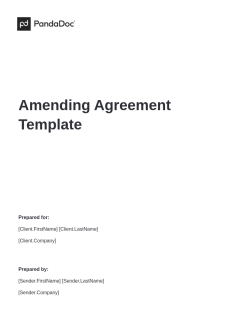Written contracts are a great way of setting boundaries for a business relationship between two parties.
Even though the original contract may seem like carved in stone agreement, unexpected situations may occur and oblige the parties to come up with a contract amendment.
There are many legal implications that are associated with amendment changes.
Moreover, international legislation varies so, depending on where the other party (or parties) are located, you might want to consider reaching out to a law firm for legal advice.
But before diving into the most complex aspects related to making modifications to an existing contract or adding a new clause into a legal document, let’s find out more about what exactly amending an existing contract is and how an original document can be altered using redlines or strikethroughs.
After analyzing over 1 800 contract amendments negotiated using the PandaDoc platform, our experts were finally able to come up with a complete guide about how to change the terms of a written agreement.
This guide is based on up-to-date rules and regulations. All contract amendments must be done only after obtaining the mutual agreement from all the parties involved.
What is a contract amendment?
Typically, a contract amendment (usually referred to as contract addendum or contract redlining) represents a mutually agreed modification made by both (or all) parties to a written agreement.
This requires both parties to perform a certain process that ensures the new clauses fulfill 3 crucial conditions:
- legal
- valid
- binding
If you have previously signed or eSigned a contract but noticed there is a mistake in it that alters the factual situation, you must inform the other party in order to create an amendment.
The main purpose of an amendment is to change the terms of a previously existing agreement between two individuals or parties.
Therefore, this new separate document may refer to a subsection of the initial contract or to the entire contract itself.
Depending on the types of contracts you have signed, there are several types of amendments you can create.
For example, if you represent a Software as a Service (SaaS) company selling web applications to business clients, contract amendments may refer to:
- duration of service (longer or shorter)
- your employees’ responsibilities
- a change in matters of monthly pricing starting from a certain date

Amending Agreement Template
Used 4874 times
This Amending Agreement Template, which must be in writing and be signed by all parties, details any alterations to the original agreement.
Use this templateWhen can you change the terms of a contract?
The short answer is anytime.
As long as both (or all) parties involved in the contract agree with the changes, amendments can be made anytime.
However, depending on the moment you want to make contract changes, there are two distinct categories: pre-signature and post-signature.
Pre-signature contract amendments are not exactly amendments to contracts. There are more like term negotiations, as changes in the original document can be easily made without altering its legality.
After negotiating with your customer and deciding on the final terms of your contract, you can edit the initial one and generate a final version of the written agreement.
This final document can be then signed by both parties and is considered a legal document. Say you have a digital marketing company that offers Social Media management services and you get a client that has several Facebook pages.
Given the fact that your contract template applies to customers that have only one Facebook page, you will have to make changes to the terms.
For example, the monthly pricing of the Social Media management services will definitely change and you will have the necessary modifications.
On the other hand, after both you and your customer have signed the contract, things get a bit more complex. This is called a post-signature amendment and requires a written agreement between the two parties.
In order to alter the original agreement, you will have to sign a new contract that defines the necessary changes. This second contract remains valid for as much time as the initial document.
The entire clause applies, according to the deletions and changes defined in the second agreement. For example, say you have a real estate business and you have previously signed a contract with one of your customers several years ago, stating a 400 USD per month rent.
However, due to the Covid 19 pandemic that affected the entire world starting from 2019, the total cost of ownership for that particular flat went up by 50%.
Yet, your customer enjoys the initially agreed price of 400 USD. If you want to change that specific price, you will have to initiate the amendment process and state the updated price in a new document.
Addendum vs. Amendment: What is the difference?
The two concepts are usually made use of interchangeably. However, the two define very distinct processes, each referring to a particular situation.
To make things easier for you to understand, we will take simple situations and explain what is the main difference between an addendum and an amendment.
Say you own a Digital Marketing business and offer Search Engine Optimization (SEO) services for your customers. You have previously signed a contract with a customer agreeing to offer your services for 750 USD per month.
This agreement includes one monthly SEO audit as well as content for two blogs per week. Thanks to your great work, your customer decides to make another important step and increases the weekly blog count to four instead of two.
This can be done by changing the terms of a contract. Therefore, you will need to create an amendment.
On the other hand, if you own the same Digital Marketing business and you encounter a client that does not have much knowledge about how an SEO audit exactly works.
After signing the contract, you prepare the first audit and send it in the form of a PDF document to your customer. Shortly after, you get a call from your customer that accuses you of sending an incomplete audit.
You try to explain the exact sections that are included in the SEO audit but your customer keeps saying that those are not clearly stated in the contract.
Therefore, if you want to clarify the terms of a contract, you will need an addendum.
Why is an amendment needed?
As you can see from the previous examples, there are many situations where an amendment proves to be very useful for a business owner.
Besides offering you the opportunity to make changes according to volatile situations, you can also make the necessary adjustments when the terms of the agreement change.
It is crucial to be able to understand the need for amendment.
Some of the most frequently encountered purposes of an agreement amendment include but are not limited to:
- fixing a typo, spelling mistake or mistyped figure
- delete a clause that is no longer relevant for your collaboration
- modify (increase or decrease) the scope of the contract
- add a new clause that was not previously mentioned
A contract may suffer several amendments, depending on the continuously changing situation.
If there are too many modifications taking place, requiring a significant number of changes to be made to the original document, you as a business owner have three available options.
You can either duplicate the contract, restate its terms or even re-execute the agreement.
How to legally amend a US-based contract?
If you have decided to change the terms of the contract you have signed inside the United States borders you will need to perform a series of steps that ensure all your actions are legal.
These contract management steps are built according to the current legislation. However, to make sure everything is according to the law, you might want to try out the legal services offered by a professional law firm.
Yet, there are many great articles referring to contract management that can be successfully used to guide your actions.
If you have already signed the contract but you want to make a modification to it, you will have to create a document, generally called a deed.
This document is the written agreement of the two parties, stating the fact that they agree to change the terms of the original contract.
In order to comply with the law, the deed must contain the following aspects:
- full names of the included parties
- date of the original contract
- the reference clauses in the amended contract
- the new clauses
- execution block (including the party names and a signature place)
This new document must be attached to the initial contract so you can prove the agreement with your client has been made and the new terms are mutually agreed.
Also, make sure you note the fact that all the other clauses maintain full force, despite the amendment.
When it comes to the actual method of changing the terms of there are three available options: strikethrough (or redline), replacing the entire clause or describing the amendment (or addendum).
In order to make things easier for you to understand, we have prepared a set of examples of how to properly use each method.
Strikethrough / Redline method
This is the simplest method associated with a physical modification of the contract. If the change is just a number or a word, you can simply use a redline to strikethrough what you want to modify.
For example, say you have a clause in your contract that states a monthly fee of 600 USD for each social media page and you want to change the price to 800 USD, based on the significant volume of work. You can do so by adding a redline over the initial price (600 USD) and write the new price.
1(C). The customer agrees to pay (strikethrough) 600 US Dollars (/strikethrough) 800 US Dollars each month for the services described in section F – Services.
Replacing the clause
This is a medium-difficulty method that is based on declaring the initial clause as null and inserting a new one.
Let’s imagine the same situation where you have an initial price of 600 USD per month but agree to change to 800 USD per month due to the volume of work.
The contract will look like this:
1(C). The customer agrees to pay 600 US Dollars each month for the services described in section F – Services.
If you want to change it, you can simply create an amendment that states the following aspects:
1. Clause 1(C) is deleted and replaced with the following clause:
1(C). The customer agrees to pay 800 US Dollars each month for the services described in section F – Services.
Describing the amendment
This is the most complex method of amending a contract after it has been signed by the two parties. It requires you to describe the changes that take place according to the new agreement.
Based on the previously-described situation, changing the price from 600 US Dollars to 800 US Dollars per month will look like this:
1. Clause 1(C) is amended by deleting “600 US Dollars” and replacing it with “800 US Dollars”.
Which is the best method?
The most appropriate method depends not only on your preferences but also on the number of amendments the contract requires.
If there is only a minor modification that must be made to the original document, you can safely stick to the strikethrough method.
However, using the redline method when making more than 5 amendments to a contract will usually result in a poor-looking document. Therefore, you can either go with the second or third method.
How to legally amend an EU-based contract?
Inside the European Union, there are many different laws that govern the two-party contracts.
Each law comes with its own procedures, depending on the state that has issued it.
One of the most commonly encountered protocols that must be followed when amending a European contract is the one that is also legal in Romania, Germany, and France.
This protocol requires the original issuer to create a new document that has a similar format to the original one and includes all the changes that are made to the written contract.
These changes can be highlighted using the article numbers that are modified.
Also, the amendment must include identification information about the original document, including the date of the signing, the parties involved, as well as the authority that has previously registered it.
A legally accepted contract amendment will usually look like this:
1. Clause 1(C) is declared null.
2. A new clause 1(C) is added and contains the following text: “The customer agrees to pay 800 US Dollars each month for the services described in section F – Services.”.
Despite the fact that it is a more complex way of amending a contract, the European method is one of the safest, as it clearly states all the modifications.
However, when it comes to amending an entire section, you can easily declare it null and write the new text.
Final thoughts
To sum thins up, amending a contract is not such a big deal. All you have to do is to follow current laws and comply with the regulations applied to both parties.
Also, please note that there are only a few methods you can legally use to modify the clauses of a previously existent contract. It is very important to clearly register the intention of the two parties to amend a contract in the post signature phase.
Amending a contract requires some solid legal knowledge. Therefore, we strongly advise you to check out the laws and regulations that your contract must comply with.
This way you will be able to prevent any unnecessary friction caused by laws interference. To make things even easier, there are many great tools available on the market.
We highly recommend you try out the new and improved PandaDoc Document and Contract Redlining Tool. It is a great tool especially if you are not that skilled in legal documents.
Frequently asked questions
-
Amending a contract is not a complex procedure. To put it in a few words, you will have to create another document registering the intention of the two parties to change the terms of the original contract. After doing so, make sure you include all the necessary modifications in the new document. Alternatively, you can use the strikethrough method to make minor corrections.
-
The main difference consists of the purpose of the document. An addendum is meant to add a clause that was not mentioned in the original contract. An amendment is meant to change the clauses listed in the initial written agreement.
-
An amendment in the EU is not very different from one in the US. The main difference consists of the way the clauses are modified. In the EU, the initial clause is declared null and then its text is changed to the new form. In the US, the clause can be easily modified without having to completely remove it.


